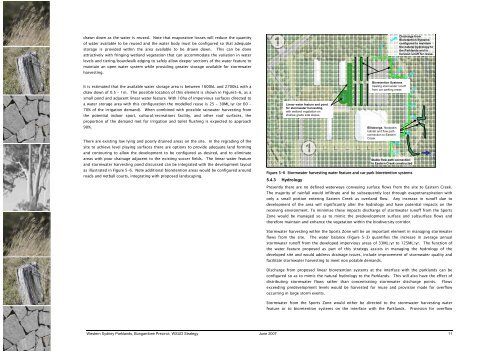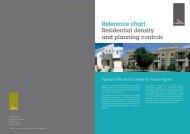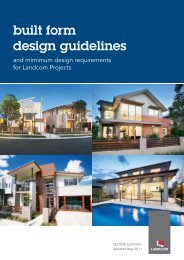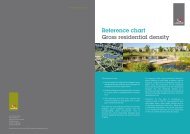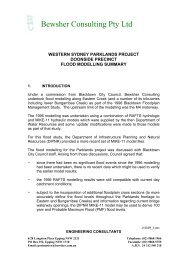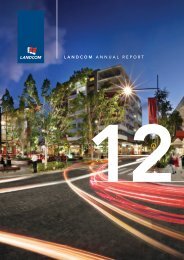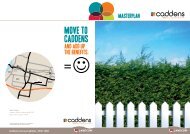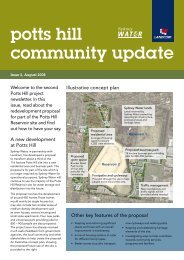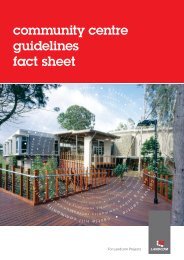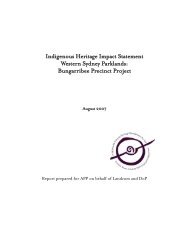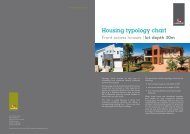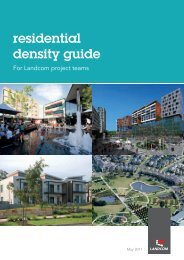WSUD Strategy
Parklands Bungarribee Precinct | WsUD Strategy Report - Landcom
Parklands Bungarribee Precinct | WsUD Strategy Report - Landcom
- No tags were found...
You also want an ePaper? Increase the reach of your titles
YUMPU automatically turns print PDFs into web optimized ePapers that Google loves.
drawn down as the water is reused. Note that evaporative losses will reduce the quantity<br />
of water available to be reused and the water body must be configured so that adequate<br />
storage is provided within the area available to be drawn down. This can be done<br />
attractively with fringing wetland vegetation that can accommodate the variation in water<br />
levels and tiering/boardwalk edging to safely allow deeper sections of the water feature to<br />
maintain an open water system while providing greater storage available for stormwater<br />
harvesting.<br />
It is estimated that the available water storage area is between 1600kL and 2700kL with a<br />
draw down of 0.5 – 1m. The possible location of this element is shown in Figure5-6, as a<br />
small pond and adjacent linear water feature. With 10ha of impervious surfaces directed to<br />
a water storage area with this configuration the modelled reuse is 25 – 30ML/yr (or 60 –<br />
70% of the irrigation demand). When combined with possible rainwater harvesting from<br />
the potential indoor sport, cultural/recreations facility, and other roof surfaces, the<br />
proportion of the demand met for irrigation and toilet flushing is expected to approach<br />
90%.<br />
There are existing low lying and poorly drained areas on the site. In the regrading of the<br />
site to achieve level playing surfaces there are options to provide adequate land forming<br />
and contouring to allow the development to be configured as desired, and to eliminate<br />
areas with poor drainage adjacent to the existing soccer fields. The linear water feature<br />
and stormwater harvesting pond discussed can be integrated with the development layout<br />
as illustrated in Figure 5-6. Note additional bioretention areas would be configured around<br />
roads and netball courts, integrating with proposed landscaping.<br />
Linear water feature and pond<br />
for stormwater harvesting,<br />
with wetland vegetation on<br />
shallow grade side slopes.<br />
`<br />
Discharge from<br />
Bioretention Systems<br />
configured to maintain<br />
the natural hydrology to<br />
the Parklands and to<br />
harvest runoff for reuse.<br />
Bioretention Systems<br />
treating stormwater runoff<br />
from car parking areas<br />
Billabongs, floodplain<br />
habitat and flow path<br />
connection to Eastern<br />
Creek.<br />
Stable flow path connection<br />
to Eastern Creek constructed<br />
Figure 5-6 Stormwater harvesting water feature and car park bioretention systems<br />
5.4.3 Hydrology<br />
Presently there are no defined waterways conveying surface flows from the site to Eastern Creek.<br />
The majority of rainfall would infiltrate and be subsequently lost through evapotranspiration with<br />
only a small portion entering Eastern Creek as overland flow. Any increase in runoff due to<br />
development of the area will significantly alter the hydrology and have potential impacts on the<br />
receiving environment. To minimise these impacts discharge of stormwater runoff from the Sports<br />
Zone would be managed so as to mimic the predevelopment surface and subsurface flows and<br />
therefore maintain and enhance the vegetation within the biodiversity corridor.<br />
Stormwater harvesting within the Sports Zone will be an important element in managing stormwater<br />
flows from the site. The water balance (Figure 5-3) quantifies the increase in average annual<br />
stormwater runoff from the developed impervious areas of 33ML/yr to 125ML/yr. The function of<br />
the water feature proposed as part of this strategy assists in managing the hydrology of the<br />
developed site and would address drainage issues, include improvement of stormwater quality and<br />
facilitate stormwater harvesting to meet non potable demands.<br />
Discharge from proposed linear bioretention systems at the interface with the parklands can be<br />
configured so as to mimic the natural hydrology to the Parklands. This will also have the effect of<br />
distributing stormwater flows rather than concentrating stormwater discharge points. Flows<br />
exceeding predevelopment levels would be harvested for reuse and provision made for overflow<br />
occurring in large storm events.<br />
Stormwater from the Sports Zone would either be directed to the stormwater harvesting water<br />
feature or to bioretention systems on the interface with the Parklands. Provision for overflow<br />
Western Sydney Parklands, Bungarribee Precinct, <strong>WSUD</strong> <strong>Strategy</strong> June 2007 11


